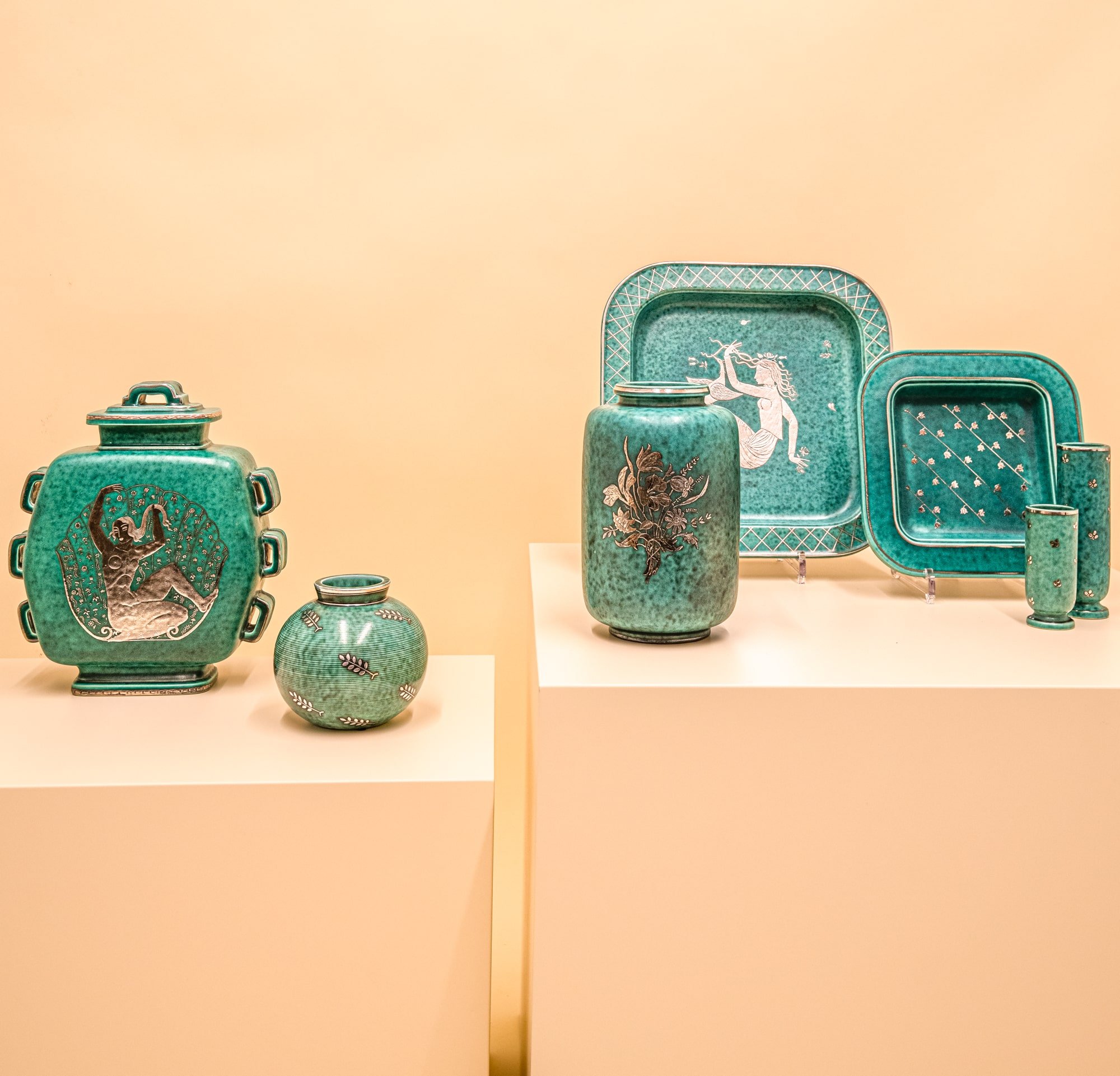Beautiful Vase by Wilhelm Kåge for Gustavsberg in the Art Deco tradition. 1930s
Truly stunning vase in ceramics decorated with leaf motifs in silver inlaid in the Art Deco tradition and style. Made in Sweden. Stamped: Gustavsberg, Kåge. The stoneware has a mesmerising green glaze. It is a very rare thing to find an Argenta piece that is so properly stamped and numbered at the bottom like this one combined with the incised lines on the body of the vase. When you buy this vase you just don't buy yet another Argenta piece, you are purchasing one of the most sophisticated but still harmonic designs we have ever seen over the years. The letter E painted in silver on the Gustavsbers anchor symbol means that this piece was made in 1935, making it an early piece since the first Argenta's was produced in 1931.
About the Designer
Period
Place of Origin
Condition
Dimensions
Truly stunning vase in ceramics decorated with leaf motifs in silver inlaid in the Art Deco tradition and style. Made in Sweden. Stamped: Gustavsberg, Kåge. The stoneware has a mesmerising green glaze. It is a very rare thing to find an Argenta piece that is so properly stamped and numbered at the bottom like this one combined with the incised lines on the body of the vase. When you buy this vase you just don't buy yet another Argenta piece, you are purchasing one of the most sophisticated but still harmonic designs we have ever seen over the years. The letter E painted in silver on the Gustavsbers anchor symbol means that this piece was made in 1935, making it an early piece since the first Argenta's was produced in 1931.
About the Designer
Wilhelm Kåge (1889-1960) is one of the most well-known representatives of the illustrious Swedish ceramic design of the 20th century. He was the artistic leader for Gustavsberg in the 1930s and 1940s and is often called the father of Swedish modernism. Kage is represented at the Swedish National Museum of Art and Design.
In the 1920s, Wilhelm created the Argenta series which was popularized at the Stockholm Exhibition of 1930. The series consisted of crocks, bowls, and vases adorned with a characteristic green glaze. The objects have silver decor with dragons, mermaids, fish, flowers and dancing women . Argenta was first manufactured in flint but later manufactured in stoneware.
In 1949, Wilhelm relinquished his role as artistic director to his colleague, Stig Lindberg. He continued his studio work at Gustavberg until his death in 1960. He is remembered as Gustavberg’s ceramic king, who for more than 40 years, guided the factory through the shifting tide of 20th century style trends and into modern times.
Period
Circa 1930
Place of Origin
Sweden
Condition
Good Vintage Condition
Dimensions
13,5 cm x 13,5 cm x 12 cm
Truly stunning vase in ceramics decorated with leaf motifs in silver inlaid in the Art Deco tradition and style. Made in Sweden. Stamped: Gustavsberg, Kåge. The stoneware has a mesmerising green glaze. It is a very rare thing to find an Argenta piece that is so properly stamped and numbered at the bottom like this one combined with the incised lines on the body of the vase. When you buy this vase you just don't buy yet another Argenta piece, you are purchasing one of the most sophisticated but still harmonic designs we have ever seen over the years. The letter E painted in silver on the Gustavsbers anchor symbol means that this piece was made in 1935, making it an early piece since the first Argenta's was produced in 1931.
About the Designer
Wilhelm Kåge (1889-1960) is one of the most well-known representatives of the illustrious Swedish ceramic design of the 20th century. He was the artistic leader for Gustavsberg in the 1930s and 1940s and is often called the father of Swedish modernism. Kage is represented at the Swedish National Museum of Art and Design.
In the 1920s, Wilhelm created the Argenta series which was popularized at the Stockholm Exhibition of 1930. The series consisted of crocks, bowls, and vases adorned with a characteristic green glaze. The objects have silver decor with dragons, mermaids, fish, flowers and dancing women . Argenta was first manufactured in flint but later manufactured in stoneware.
In 1949, Wilhelm relinquished his role as artistic director to his colleague, Stig Lindberg. He continued his studio work at Gustavberg until his death in 1960. He is remembered as Gustavberg’s ceramic king, who for more than 40 years, guided the factory through the shifting tide of 20th century style trends and into modern times.
Period
Circa 1930
Place of Origin
Sweden
Condition
Good Vintage Condition
Dimensions
13,5 cm x 13,5 cm x 12 cm



